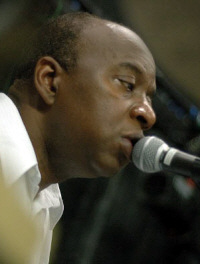Article in DNA, March 7, 2009 on Jalalu's concert in Saint-Louis, France (in French)
Article in DNA, February 7, 2009 on Jalalu's performance at the opening of an exhibition by Koffi-Yao (in French)
Press release by Northwest School of the Arts, April 2008
“What carries this cornucopia of images – or indeed steals the show – is the musical creation of the masterful Jalalu-Kalvert Nelson, jazzman, composer and one-man-orchestra. He is there on stage, conjuring up wonderland with his beautiful voice, trumpet and percussion. The laughter, shouts and silences of the infant school audience who have come to watch Les Rêves de Karabine Klaxon are proof of how much they enjoy immersing themselves in this lovely show.”
- Muriel Plantier, Midi Libre, November 30 2007
“Jalalu-Kalvert Nelson's Pavane is an innovative fifteen-minute piece full of rhythmic surprises, urgent expressivity and dark, indeed tragically tinted ideas that speak of inner distress and attempts to free the spirit.”
- Der Bund, January 23, 2001
“There was a great deal of vivid, particular life in Jalalu-Kalvert Nelson's score”
- New York Times, March 24, 1994 (New York premiere of Fantomes by the Limon Dance Company)
“Namings by New York composer Jalalu-Kalvert Nelson draws on the Dale Warland Singers' vocabulary of radical vocal techniques. ... He uses words to form patterns, breaking them up and stretching them, somewhat in the manner of Luciano Berio's Sinfonia, though with more rhythmic emphasis than in that work. As a climax, the words are all reiterated in a chant-like, gradually ascending phrase, as if the memory of slavery and origin – the collective memory of Afro-Americans – were finally being confronted and ultimately banished. Nelson's impressive Namings would need repeated listenings in order to get all the words. But it makes an impact and draws one in on a first hearing.”
- Michael Anthony, Minneapolis State Ledger, November 10 1992
Listen to this piece (mp3, 10:52)
“Timeloss is a powerful memorial to three of the composer's friends who died recently. This is not a calm, philosophical acceptance of death. The work's textures are spare and pained, its gestures are emphatic, and its language is essentially atonal, with some Messian-like mysticism. Each player is given a searing cadenza that conveys a sense of rage taken beyond articulateness into the realm of pure emotion. It is not a pretty work, but it is clearly a moving one. The Y's normally conservative audience gave it a warm, sustained ovation”
- Allan Kozinn, New York Times, December 7 1989
